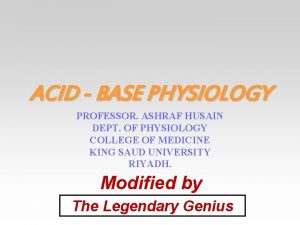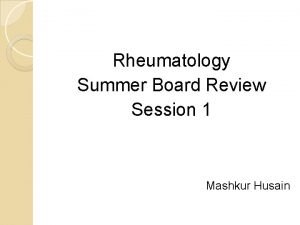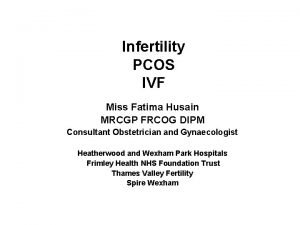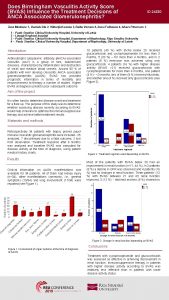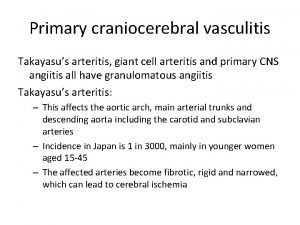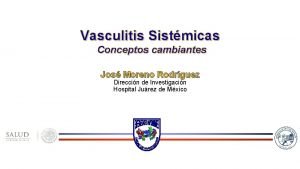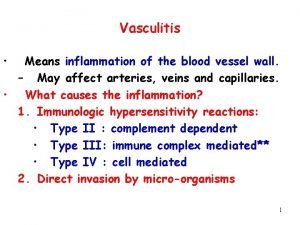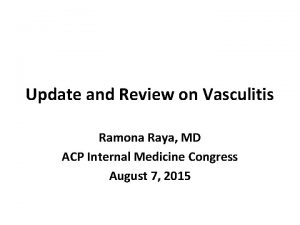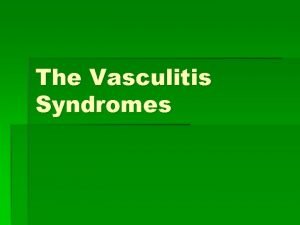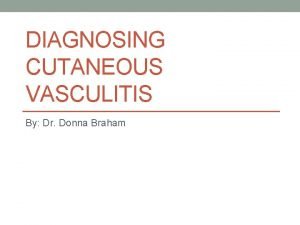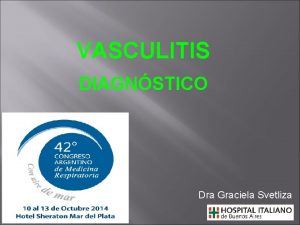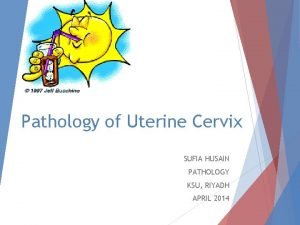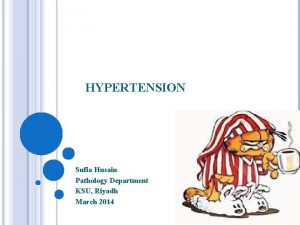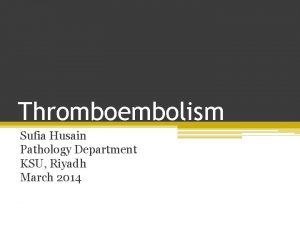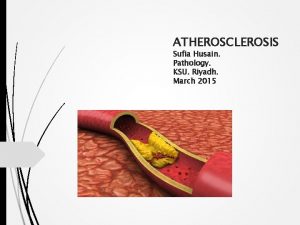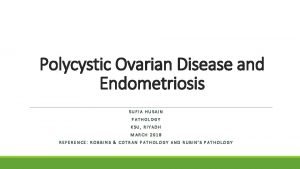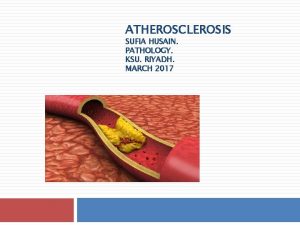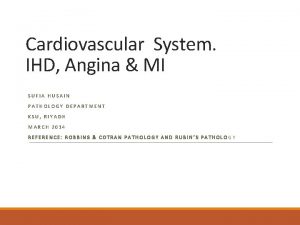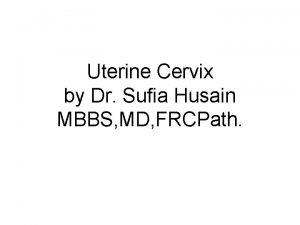Vasculitis Sufia Husain Associate Professor Pathology Department College



































- Slides: 35

Vasculitis Sufia Husain Associate Professor Pathology Department College of Medicine KSU, Riyadh February 2019 Reference: Robbins & Cotran Pathology and Rubin’s Pathology

Objectives: At the end of this lecture, the student should: ▪ Know the common causes of vasculitis with special emphasis on the clinic-pathological features and mechanism of: Giant cell arteritis. Polyarteritis nodosa. Wegener's granulomatosis. Cutaneous hypersensitivity vasculitis. Thromboangiitis obliterans (Burger’s disease) Key principles to be discussed: ▪ Pathology of vasculitis: giant cell arteritis, polyarteritis nodosa, Wegener's granulomatosis and cutaneous hypersensitivity vasculitis. ▪ Key principles to be reviewed by self-teaching (additional reading): Henoch Schonlein purpura

Lecture outline ▪ Giant cell arteritis. ▪ Polyarteritis nodosa. ▪ Wegener's granulomatosis. ▪ Cutaneous hypersensitivity vasculitis and Henoch Schonlein purpura. ▪ Thromboangiitis obliterans (Burger’s disease)

Vasculitis It is inflammation of vessel walls with many possible symptoms Causes: 1. Most cases of vasculitis are immune-mediated v Immune complex deposition v Antineutrophil cytoplasmic antibodies (ANCAs) v Anti-endothelial cell antibodies v Autoreactive T cells 2. Vasculitis can also be caused by infection, physical or chemical injury

Giant-Cell (Temporal) Arteritis

Giant-Cell (Temporal) Arteritis Most common type of vasculitis Patients more than 50 yrs of age Female: Male = 2: 1. Chronic, granulomatous inflammation of large to medium sized arteries, especially the branches of the carotid artery in the head (temporal artery and branches of the ophthalmic artery) Involvment is segmental, acute and chronic.

Giant-Cell (Temporal) Arteritis: Clinical Features § Symptoms : ü fever, facial pain or headache, often most intense along the course of the superficial temporal artery, ü Thickened and painful temporal artery ü Jaw pain ü Visual problems and acute vision loss § The diagnosis depends on biopsy and histologic confirmation. § Treatment: corticosteroids

Biopsy of Giant-Cell (Temporal) Arteritis: morphology § Granulomatous inflammation of the blood vessel wall § Giant cells § Disruption and fragmentation of internal elastic lamina § Proliferation of the intima with associated occlusion of the lumen. § The healed stage reveals collagenous thickening of the vessel wall and the artery is transformed into a fibrous cord

Polyarteritis Nodosa

Polyarteritis Nodosa § Disease of young adults. § There is segmental necrotizing inflammation of arteries of medium to small size, in any organ except the lungs. § Most frequently kidneys (most common), heart, liver, and gastrointestinal tract. § Polyarteritis nodosa has been associated with hepatitis B or hepatitis C virus infection. Clinical features § Some clinical manifestations are due to ischemia and infarction of affected tissues/ organs. § Fever, weight loss, abdominal pain and melena (bloody stool), muscular pain and neuritis.

Polyarteritis nodosa with segmental inflammation and fibrinoid necrosis and occlusion of the lumen of this artery. Note that part of the vessel wall at the left side is uninvolved.

Polyarteritis Nodosa § Weakening of the arterial wall due to the inflammatory process may cause aneurysmal dilation or localized rupture. § Renal arterial involvement is often prominent and is a major cause of death. § Particularly characteristic of PAN is that all the different stages of activity ( i. e. active and chronic stages) may coexist in same artery or in different artery at the same time. § Fatal if untreated, but steroids and cyclophosphamide are curative.

Granulomatosis with Polyangiitis (also known as Wegener granulomatosis)

Granulomatosis with Polyangiitis (also known as Wegener granulomatosis) is a type of necrotizing vasculitis characterized by the triad of 1) necrotizing granulomas of the upper and lower respiratory tract 2) necrotizing or granulomatous vasculitis of small to mediumsized vessels 3) renal disease in the form of necrotizing, crescentic, glomerulonephritis.

Granulomatosis with Polyangiitis (also known as Wegener granulomatosis) § Males are affected more often than females, at an average of about 40 years § C-ANCAs (antineutrophilic cytoplasmic antibodies) is positive in serum of more than 95% of patients. § Persistent pneumonitis , chronic sinusitis , mucosal ulcerations of the nasopharynx , and evidence of renal disease. § Untreated: fatal - may lead to death within 2 years if not treated.

Wegener granulomatosis: palatal ulceration

Wegener granulomatosis: palatal destruction

Granulomatosis with Polyangiitis (also known as Wegener granulomatosis)

Granulomatosis with Polyangiitis (also known as Wegener granulomatosis)

Microscopic polyangitis/ polyarteritis

Microscopic polyangitis/ polyarteritis ▪ It is a systemic small vessel vasculitis associated with glomerulonephritis (renal disease). ▪ P-ANCA is characteristically present ▪ In the past it has been confused with leukocytoclastic vasculitis.

Churg-Strauss syndrome (additional reading) ▪ Eosinophil-rich and granulomatous inflammation involving the respiratory tract and necrotizing vasculitis affecting small vessels ▪ Associated with asthma and blood eosinophilia ▪ Associated with p-ANCAs.

Cutaneous leukocytoclastic (hypersensitivity vasculitis/ angiitis)

Cutaneous leukocytoclastic (hypersensitivity vasculitis/ angiitis) § Necrotizing vasculitis of arterioles, capillaries, venules. § is inflammation of small blood vessels § commonly seen in the dermis of skin characterized by palpable purpura. § It is the most common vasculitis seen in clinical practice. § Leukocytoclasis refers to the nuclear debris of infiltrating neutrophils in and around the vessels. § All lesions tend to be of the same age. § It affects many organs e. g. skin (most common), mucous membranes, lungs , brain, heart, GI , kidneys and muscle.

Cutaneous leukocytoclastic (hypersensitivity vasculitis/angiitis) Causes: § Idiopathic § Immunologic reaction to an antigen that may present as ▪ Drugs e. g. penicillin ▪ Infectious microrganisms e. g. strept. and other infections, ▪ heterologous proteins, ▪ food products and toxic chemicals ▪ tumor antigens in various cancers. § It may be a part of a systemic diseases e. g: ▪ Collagen vascular diseases (lupus erythematosus, rheumatoid arthritis) ▪ Henoch-Schonlein purpura

Henoch-Schonlein purpura (HSP) § HSP is an Ig. A-mediated, autoimmune systemic disease in which the small vessels show leukocytoclastic vasculitis. § The etiology remains unknown. § Serum levels of Ig. A are high in HSP § Skin biopsy will show necrotizing leukocytoclastic vasculitis of capillaries in the dermis. § The immunofluorescence shows Ig. A immunoglobulin deposition in the wall the affected capillaries.

Cutaneous leukocytoclastic (hypersensitivity vasculitis/ angiitis) § Skin biopsy is often diagnostic. § Histologically there is infiltration of vessel wall with neutrophils, which become fragmented called as leukocytoclasia or nuclear dust. § The direct immunofluorescence will show deposits of IGA immunoglobulin in the wall the capillaries By Emmanuelm at en. wikipedia, CC BY 3. 0, https: //commons. wikimedia. org/w/index. php? curid=4233591

Leukocytoclastic vasculitis in a skin biopsy showing fragmentation of neutrophil nuclei in and around vessel walls.

Thromboangiitis obliterans (Buerger disease)

Thromboangiitis obliterans (Buerger disease) § It is characterized by segmental, thrombosing, acute and chronic inflammation of medium-sized and small arteries, principally of the leg and hands (tibial and radial arteries) with secondary extension into adjacent veins and nerves. § Buerger disease is a condition that occurs almost exclusively in heavy smokers of cigarettes § Patients are usually under 35 years of age. § Tobacco either leads to direct toxicity to endothelium, or induces an immune response www. globalskinatlas. com

Thromboangiitis obliterans (Buerger disease) § Clinical features include: pain in the affected hand or foot induced by exercise (called instep claudication). Patients can have pain even at rest, due to the neural involvement. Chronic ulcerations of the toes, or fingers may appear, followed in time by gangrene. § Abstinence from cigarette smoking in the early stages of the disease brings relief from further attacks

Thromboangiitis obliterans (Buerger disease) § Microscopically, there is acute and chronic inflammation, accompanied by luminal thrombosis. The inflammatory process extends into adjacent veins and nerves (rare with other forms of vasculitis), and in time all three structures become encased in fibrous tissue. https: //serendipityproject. files. wordpress. com/2011/09/plate-iii-buergers-disease. jpg

http: //4. bp. blogspot. com/-b. Zxb. Ar 2 d. Kw 0/Vc. C 6 qks. T 8 k. I/AAAABes/xvv. UOd. Wi. Ix. M/s 640/Buerger%2 BDisease. PNG

Summary of Vasculitides Vessel Large Medium Small Disease comment Giant-cell arteritis >50 yr. Arteries of head. Takayasu arteritis F <40 yr. “Pulseless disease” Polyarteritis nodosa Young adults. Widespread. Kawasaki disease <4 yr. Coronary disease. Lymph nodes. Berger’s disease 35 yrs, smokers, extremities Wegener granulomatosis Lung, kidney. c-ANCA. Churg-Strauss syndrome Lung. Eosinophils. Asthma. p-ANCA. Microscopic polyangiitis Lung, kidney. p-ANCA. Cutaneous leukocytoclastic vasculitis Idiopathic, infectious, drugs, chemicals, cancer and systemic disease like HNP

http: //www. arthritisresearchuk. org/~/media/Images/Educational-resources/Reports%20 images/TR_7_1_fig 1. ashx? la=en
 Promotion from associate professor to professor
Promotion from associate professor to professor Waris husain
Waris husain Ashraf husain
Ashraf husain Ashraf husain
Ashraf husain Most likely diagnosis
Most likely diagnosis Miss fatima husain
Miss fatima husain Associate degree in nursing lone star college
Associate degree in nursing lone star college Harper college
Harper college Birmingham vasculitis activity score
Birmingham vasculitis activity score Vasculitis
Vasculitis Vasculitis
Vasculitis Vasculitis
Vasculitis Wegener's vs churg strauss
Wegener's vs churg strauss Vasculitis
Vasculitis Takayasu arteritis
Takayasu arteritis Sle vasculitis
Sle vasculitis Vasculitis tratamiento
Vasculitis tratamiento Kawasaki disease
Kawasaki disease Ramona raya
Ramona raya Vasculitis
Vasculitis Dr donna braham dermatologist
Dr donna braham dermatologist Anca p
Anca p A college professor never finishes his lecture
A college professor never finishes his lecture Pasadena city college police department
Pasadena city college police department Bcs professional member
Bcs professional member Tecniche associate al pensiero computazionale
Tecniche associate al pensiero computazionale The pyramid at chichen itza is most closely associate with
The pyramid at chichen itza is most closely associate with What is incose
What is incose Direct mapping disadvantages
Direct mapping disadvantages Home institution declaration cern
Home institution declaration cern Associate degree pie
Associate degree pie Berstoff gearbox repair
Berstoff gearbox repair Physician associate lecturer
Physician associate lecturer Rcog associate
Rcog associate Associate degree duo gift
Associate degree duo gift What is an associate director
What is an associate director



